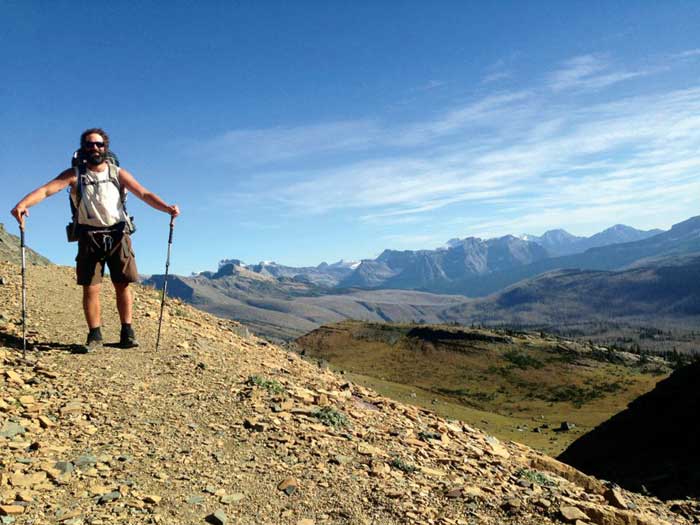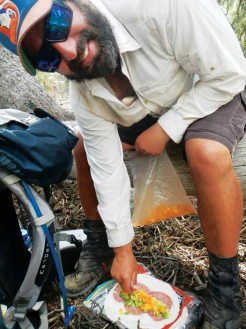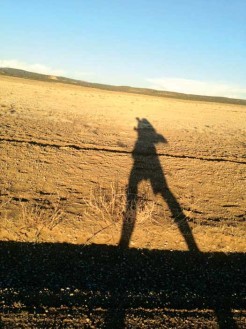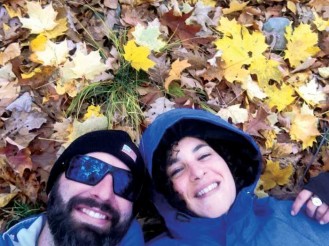Hint: It’s not glamorous

Mark Karum pauses at one of the hundreds of sweeping views along the Continental Divide Trail.
Many people move to Denver to be close to the outdoors, and for most, adventures range from weekend hikes to weeklong backpacking trips. But there are few like Mark Karum who hike the 2,900-mile Continental Divide Trail alone.
People ask him, “Why would you want to do that?” He says he wanted the solitude—he didn’t fear it like people expected he would.
Karum moved to Park Hill 11 years ago and resided there until recently. He says he’s tried to be normal, but inevitably time after time he gets sick of city life and escapes to the outdoors, always returning to Park Hill in between.

Building up “out-of-control appetites” from long hiking days, Karum ate unusual meals on the trail, like his tortilla, salami and crunched Cheetos combination shown here.
The Continental Divide Trail stretches from Mexico to Canada. Of the three longest U.S. trails, it has the fewest hikers—many attempt it and quit after a couple months. Romantic notions of being at one with nature for months on end don’t match reality. Backpacker Magazine calls it “the biggest, baddest, long-distance path of them all.” According to National Geographic, the trail is only 70 percent complete and takes careful navigation. Conditions range from scarce water sources in New Mexico deserts to steep inclines in the Rockies to grizzly bear country in Wyoming. Besides the physically grueling aspect, the trail tends to change those who dare to hike it in unexpected ways.
“The physical part you can be in shape for,” Karum says. “(For) the mental you have to be steady.”
Six feet, tan and muscular, Karum looks like a mountaineering man. Like steel wool worn out from scrubbing too many pans, his beard is wiry with touches of silver. Although a sturdy hulk of a man, he has a surprisingly jolly smile.
He grew up on a big pasture in Oklahoma. Creeks, ponds and open land were his backyard. He spent nearly all of his time outside and recalls from an early age wanting to be away from people, which inspired his long hikes.
He hiked the 500-mile Colorado Trail once in 2008 and twice in 2010 and the 2,650-mile Pacific Crest Trail in 2011. Prior to three of the hikes, each girlfriend at the time dumped him, an unfortunate pattern but it never stopped him from hiking more.

Conditions along the trail range from scarce water sources in New Mexico deserts to steep inclines in the Rockies to grizzly bear country in Wyoming.
He prepared for the Continental Divide Trail for two years, running three miles in the morning, working his mechanic job during the day and lifting weights at night. When he started his trip at the Mexico border, he couldn’t stop crying. He had made it, finally.
“I was so sad to be leaving everybody but so happy to start the trail. All the planning and putting things into order finally comes down to the last thing of getting dropped off.”
This time he was leaving behind Jessica—the only girlfriend to not break up with him. She’s a Denver native but Brooklyn resident for the past 10 years. Unlike Karum, she’s never had the outdoors bug. They met in Denver and continued to date long distance, even when he set off for the trail.
Karum hiked 10 to 12 hours a day, averaging 28 miles on a good day and sometimes only 12 miles on days entirely spent trudging through waist-deep snow.
At night, he sipped tea and ate his favorite food invention—a tortilla filled with Mac and Cheese, tuna and Triscuits, something he still craves after the trail. He watched stars, which seemed almost touchable.
The trail went through towns where Karum could do laundry and resupply, a dreamlike experience after spending weeks on the trail, sometimes going 40 miles between water sources. He’d count down to “Town Day,” dreaming of breakfast food and a Kevin Costner movie on the motel TV. Once he got into town, money meant nothing, and by the end he had spent $9,000 at his town stops.
After a while on the trail, what he loved—being alone—also became what he hated. Loneliness set in. To stay entertained, he listened to music, comedy skits and audiobooks.
Soon, the trail became a hike through his past. “I always thought of the bad stuff, stuff you try to push away.” His mind kept going back to bullying other kids in school and getting into fights as a “young punk.” Deprived of human contact, other hikers latched on to Karum and “spilled their guts.” Some days he cried or cursed or wanted to quit.
“I’d climb up a mountain and be like, ‘Oh sweet, another view. Now I have to climb that one.’”

Karum smiles with his girlfriend Jessica who he now lives with in New York.
Then there was his relationship with Jessica. When he got cell service he’d call or Facetime her, but most conversations turned into fights. “I’d have to hang up the phone and then try to navigate my way through this giant lava field.”
He felt caught between two versions of himself—trail Mark and city Mark. Those two collided when he returned to Denver. He couldn’t quite explain his feelings, but he knew his goals: to be normal and be a good boyfriend.
After returning to Park Hill, it wasn’t long before Karum moved to Brooklyn to be with Jessica. “If she’s cool enough to be with me through this, I owe her my true effort to build the relationship.” Their Brooklyn home has a small backyard and nearby park, but Karum fears missing the wide open. “I don’t know if I can act the same with her without that part of me.”
To learn more about transcontinental hikes, Karum recommends Jackie McDonnell’s Yogi’s Guidebooks. For another account of the trail, read “Walking With Wired,” a blog authored by Erin Saver, a woman who blogs while hiking long trails.




0 Comments